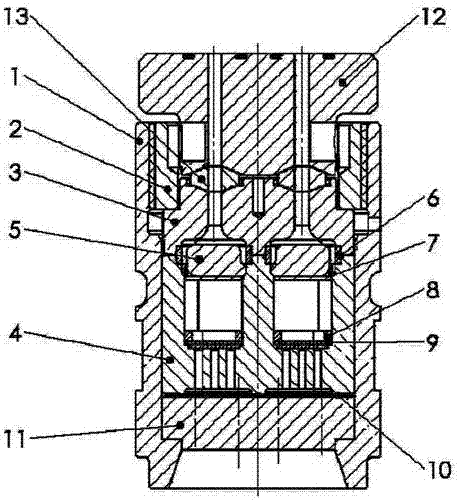Anti-adhesion double-cavity spinning assembly
A double-cavity spinning assembly and anti-adhesion technology, which is applied in the direction of spinneret assemblies, textiles and papermaking, and can solve problems such as contact, unfavorable production, and adhesion
- Summary
- Abstract
- Description
- Claims
- Application Information
AI Technical Summary
Problems solved by technology
Method used
Image
Examples
Embodiment Construction
[0031] The present invention will be described in detail below in conjunction with specific embodiments and drawings.
[0032] An anti-adhesion dual-cavity spinning component, which is composed of the following components: component housing 1, locking ring 2, upper cover 3, double-cavity sand cup 4, waist-shaped distribution plate 5, waist-shaped sealing ring 6, pressure sand Plate 7, aluminum sealing ring 8, multi-layer filter screen 9, integral sealing gasket 10, spinneret 11, component connecting block 12, gasket 13; component housing 1 surrounds the entire component and passes through the locking ring 2 The internal components of the module are locked with the module housing 1; the double-cavity sand cup 4 and the upper cover 3 are arranged from bottom to top as follows: multilayer filter screen 9, aluminum sealing ring 8, sand pressing plate 7 and waist The distribution plate 5 is connected by a waist-shaped sealing ring 6. An integral sealing gasket 10 is arranged between t...
PUM
| Property | Measurement | Unit |
|---|---|---|
| surface area | aaaaa | aaaaa |
| surface area | aaaaa | aaaaa |
Abstract
Description
Claims
Application Information
 Login to View More
Login to View More - R&D
- Intellectual Property
- Life Sciences
- Materials
- Tech Scout
- Unparalleled Data Quality
- Higher Quality Content
- 60% Fewer Hallucinations
Browse by: Latest US Patents, China's latest patents, Technical Efficacy Thesaurus, Application Domain, Technology Topic, Popular Technical Reports.
© 2025 PatSnap. All rights reserved.Legal|Privacy policy|Modern Slavery Act Transparency Statement|Sitemap|About US| Contact US: help@patsnap.com

